Persamaan Kuadrat •Part 1: Menyelesaikan Persamaan Kuadrat dengan Pemfaktoran / Faktorisasi Tipe 1&2
Summary
TLDRThis video introduces the concept of solving quadratic equations, focusing on the first method of factorization. It explains the general form of quadratic equations (ax² + bx + c = 0) and the conditions under which the equation is quadratic. The video covers three methods of solving quadratic equations: factorization, completing the square, and using the quadratic formula. Special emphasis is placed on factorization techniques, explaining how to identify factors and solve equations through them. It also explains the difference between factors and roots of quadratic equations, providing examples for better understanding.
Takeaways
- 😀 Quadratic equations have the general form ax² + bx + c = 0, where a, b, and c are constants, and the variable x is raised to the power of 2.
- 😀 The coefficient 'a' cannot be 0 in a quadratic equation, as this would turn it into a linear equation.
- 😀 There are three main methods to solve quadratic equations: factorization, completing the square, and using the quadratic formula (abc formula).
- 😀 The factorization method relies on finding two factors of the equation that multiply to give 0, meaning at least one factor must be 0.
- 😀 The process of factorization involves breaking down the quadratic equation into two factors and solving for x by setting each factor equal to 0.
- 😀 In factorization, it is important to understand the difference between 'factors' (like x and x+6) and 'roots' (the solutions such as x=0 or x=-6).
- 😀 Factorization type 1 involves equations where c = 0, simplifying the process to extracting x from the equation.
- 😀 In factorization type 2, where b = 0, the equation takes the form ax² + c = 0, and can be solved using the difference of squares method (a² - b² = (a - b)(a + b)).
- 😀 For factorization type 2, it is necessary to ensure that the constant c is negative to apply the difference of squares method correctly.
- 😀 The quadratic formula is a universal method that can be applied to any quadratic equation, although it was not explicitly detailed in this script.
- 😀 The script concludes by emphasizing the importance of practice and understanding the different factorization types to effectively solve quadratic equations.
Q & A
What is the general form of a quadratic equation?
-The general form of a quadratic equation is ax² + bx + c = 0, where 'a', 'b', and 'c' are constants, and 'a' cannot be equal to 0.
Why can't 'a' be equal to 0 in a quadratic equation?
-If 'a' equals 0, the equation no longer has a quadratic term (x²), and it becomes a linear equation, which is not considered a quadratic equation.
How many solutions does a quadratic equation typically have?
-A quadratic equation typically has two solutions, though in some cases, the solutions can be the same, resulting in one solution.
What is the first method for solving a quadratic equation mentioned in the video?
-The first method for solving a quadratic equation discussed in the video is factorization, where the equation is factored into two binomial terms.
What principle does factorization rely on when solving quadratic equations?
-Factorization relies on the principle that if two numbers multiply to 0, at least one of them must be 0, i.e., if M * N = 0, then either M = 0 or N = 0.
What is the process for solving a quadratic equation by factorization?
-To solve by factorization, the equation is first factored into two terms, and then each factor is set equal to 0. Solving these two equations gives the solutions for x.
What is the difference between 'factors' and 'roots' (or 'solutions') of a quadratic equation?
-'Factors' are the expressions that multiply together to form the quadratic equation, while 'roots' or 'solutions' are the values of x that satisfy the equation (make it true).
What is a characteristic of Type 1 factorization?
-In Type 1 factorization, the constant term (c) is 0, so the equation is of the form ax² + bx = 0, which can be factored by pulling out 'x'.
What is the method for solving equations with no linear term (b = 0)?
-For equations with no linear term (b = 0), the equation is factored using the difference of squares formula, a² - b² = (a - b)(a + b), to split the equation into two factors.
How is the principle of 'difference of squares' applied in Type 2 factorization?
-In Type 2 factorization, if the equation has no linear term (b = 0), it is rewritten in the form a² - b² = 0, allowing the use of the difference of squares formula to factor the equation.
Outlines

このセクションは有料ユーザー限定です。 アクセスするには、アップグレードをお願いします。
今すぐアップグレードMindmap

このセクションは有料ユーザー限定です。 アクセスするには、アップグレードをお願いします。
今すぐアップグレードKeywords

このセクションは有料ユーザー限定です。 アクセスするには、アップグレードをお願いします。
今すぐアップグレードHighlights

このセクションは有料ユーザー限定です。 アクセスするには、アップグレードをお願いします。
今すぐアップグレードTranscripts

このセクションは有料ユーザー限定です。 アクセスするには、アップグレードをお願いします。
今すぐアップグレード関連動画をさらに表示

Solving Quadratic Equations

Persamaan Kuadrat • Part 4: Menyelesaikan Persamaan Kuadrat dengan Rumus abc

Persamaan Kuadrat part. 1

Bilangan Kompleks • Part 2: Bilangan Imajiner

Solving Quadratic Equations by Factoring @MathTeacherGon - Grade 9 Math

Persamaan Eksponen Dalam Bentuk Kuadrat || Matematika Kelas X || #OprekMafiki
5.0 / 5 (0 votes)
